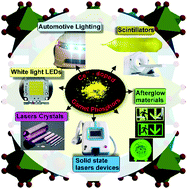Chem. Mater., 2017, 29, 3, 1430–1438. https://doi.org/10.1021/acs.chemmater.7b00006

Local structure modification in solid solution is an essential part of photoluminescence tuning of rare earth doped solid state phosphors. Herein we report a new solid solution phosphor of Eu2+-doped xSr2Ca(PO4)2–(1–x)Ca10Li(PO4)7 (0 ≤ x ≤ 1), which share the same β-Ca3(PO4)2 type structure in the full composition range. Depending on the x parameter variation in xSr2Ca(PO4)2–(1 – x)Ca10Li(PO4)7:Eu2+, the vacancies generated in the M(4) site enable the nonlinear variation of cell parameters and volume, and this increases the magnitude of M(4)O6 polyhedra distortion. The local structure modulation around the Eu2+ ions causes different luminescent behaviors of the two-peak emission and induces the photoluminescence tuning. The shift of the emission peaks in the solid solution phosphors with different compositions has been discussed. It remains invariable at x ≤ 0.5, but the red-shift is observed at x > 0.5 which is attributed to combined effect of the crystal field splitting, Stokes shift, and energy transfer between Eu2+ ions. The temperature-dependent luminescence measurements are also performed, and it is shown that the photoionization process is responsible for the quenching effect inflatable shelter.




